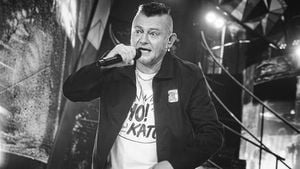With the war in Ukraine entering another challenging phase, various nations have stepped up their support, each playing distinct roles. Recently, Polish aid to Ukraine has gained attention, placing Poland at the forefront of support when measured against its gross domestic product (GDP). The Polish government has made significant contributions, amounting to 4.91% of its GDP, which includes military assistance and refugee aid. This commitment stands out against the backdrop of global responses to the conflict, highlighting Poland's proactive role.
According to the Polish President's Office, military support constitutes 0.71% of Poland’s GDP, with the remaining 4.2% directed toward assisting refugees fleeing the war. Notably, Poland has transferred around 3.23 billion euros worth of military equipment to Ukraine, including heavy weapons like tanks and armored personnel carriers. Polish President Andrzej Duda emphasized the swift and effective response his country provided during Ukraine's most arduous moments of the war.
The batch of heavy armaments supplied by Poland includes approximately 800 tanks, of which over 350 have come directly from Polish stock. This remarkable contribution surpasses the combined efforts of allies such as the United States, United Kingdom, Germany, Sweden, Norway, and Spain. Initially, Poland sent T-72 tanks to Ukraine, followed by the more sophisticated Leopard 2A4 tanks early this year. The effort didn’t stop there; Poland has also supplied drones and anti-aircraft systems, with over 100 million units of various munitions sent to support the Ukrainian military.
Not just limited to weaponry, Poland's support also encompasses technology and training. The Polish government has distributed 20,000 Starlink kits to assist with communication and operational stability. Seeing the urgency of the situation, Poland also took the initiative to organize over 500 training exercises for Ukrainian soldiers, with about 25,000 personnel receiving military training. Many of these exercises were conducted as part of the European Union’s Military Assistance Mission.
Meanwhile, the broader global picture reveals challenges faced by both the Ukraine resistance and the Russian forces. Reports from the Institute for the Study of War indicate heavy losses among Russian troops, raising concerns over their ability to sustain current operational tempo. With Russian casualties reportedly near 1,200 daily—translational to pre-emptive caution against imposing another forced mobilization—the situation for Russian military tactics appears dire.
The losses have purportedly diminished their armaments significantly. Since late last year, Russian forces have lost approximately five divisions of armored vehicles and tanks. This shocking depletion has raised questions about the sustainability of their military aggression against Ukraine. Recent assessments suggest, with Russian troops stocking their frontlines, the operational long-term viability of the current thrust is extremely jeopardized by these losses.
The changing battlefield dynamics have not only affected logistics but also morale. Russian military bloggers and commentators are quickly losing faith, criticizing leadership for utilizing outdated tactics seen as reckless. Behind the scenes, the high death count of infantry units paints a grim picture of the frontline, leading some to voice serious concerns over the treatment of their military personnel.
The impact of the conflict and the subsequent military dynamics could significantly shape the geopolitical climate for Europe. Estonian Prime Minister Kristen Michal has voiced her belief of how support for Ukraine would influence future EU stability, especially as European nations solidify alliances and innovative strategies to counteract aggression as seen from the United States under certain upcoming administration shifts.
While various nations are strategizing their actions to maintain momentum against Russian aggression, discussions about potential ceasefires and peace negotiations persist. The recent speculation surrounding U.S. efforts to announce ceasefire plans and security guarantees echoes through the lines of Eastern European defense mindset. Poland's Prime Minister has conveyed optimism of such negotiations easing the conflict, stemming from dialogues on both sides of the spectrum.
The situation is fluid, and as Europe approaches the winter months, leaders are now faced with the dual challenges of preparing defenses and continuing humanitarian support for displaced populations affected by the war. Diplomatic relations and logistical partnerships will be increasingly under scrutiny as the realities of the war evolve.
Support for Ukraine, both military and humanitarian, remains of utmost importance for the alliance of nations engaged. Poland continues to lead the charge, ensuring its place as both defender and ally. The broader international community's response could define the path forward, and discussions initiated now may yield major ramifications moving forward.
The Russian military's enduring issues involving equipment losses and the low morale of its troops could redefine the operational approach of its commanders, compelling them to make tough decisions on how best to allocate their remaining military resources. With the Ukrainian resistance showcasing resilience and receiving military support from numerous countries like Poland, the outcome of this conflict, driven by both immediate needs and long-term strategies, remains uncertain.
While the efficacy of military support systems continues to adapt and change with the ebb and flow of battlefront conditions, the humanitarian impact remains at the forefront. The assistance provided by nations such as Poland not only reflects geopolitical alliances but also responds to the humane calls from the warzone, establishing the need for coordinated efforts as the fallout from this conflict continues to challenge the global community.



